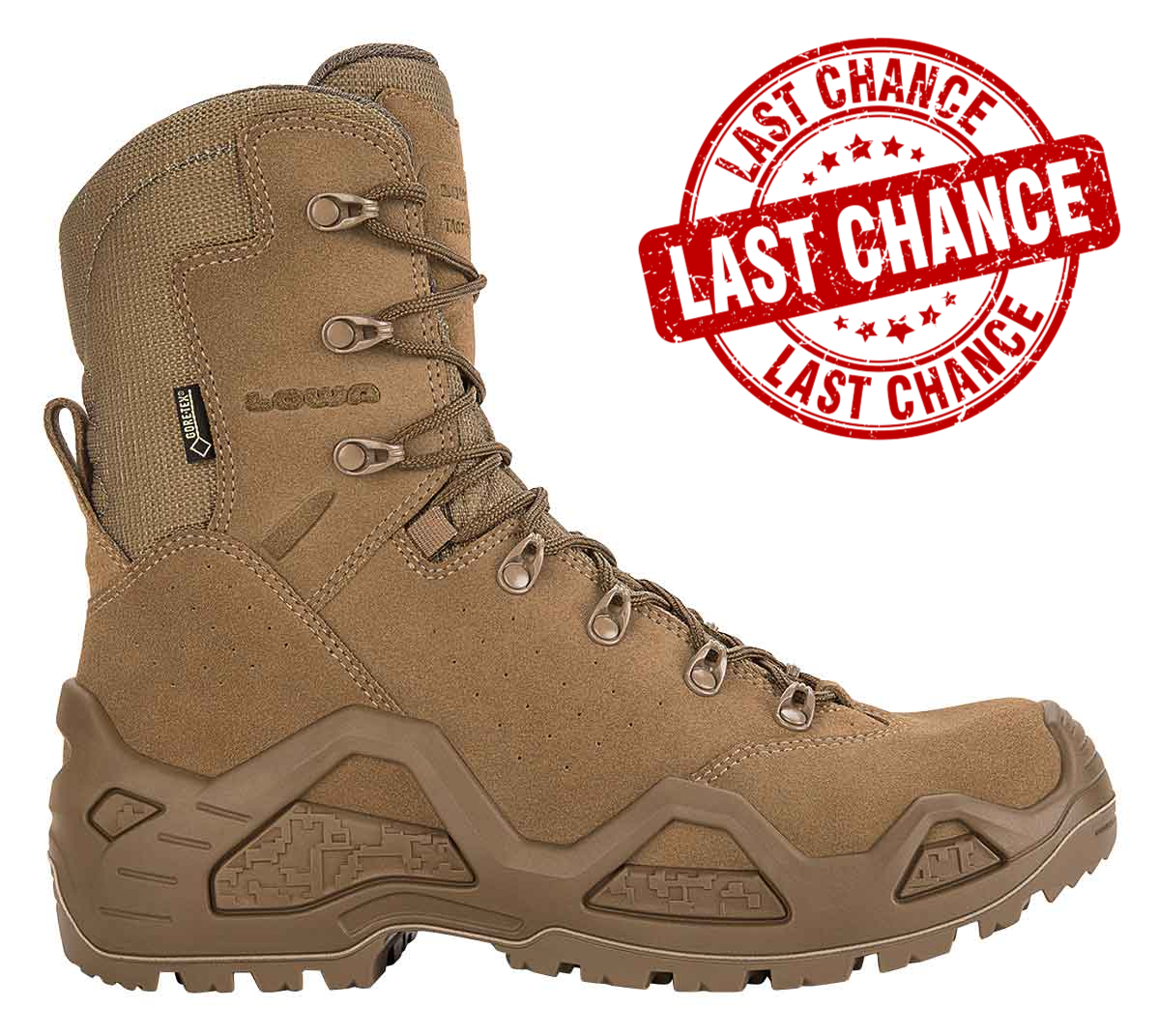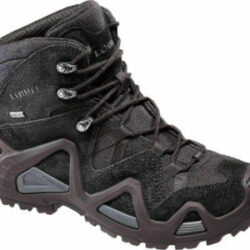LOWA Z-8S GTX® Ws
$370.00
$370.00

Description
With the LOWA Z-8S GTX® Ws, LOWA has created a robust task-force boot that is both very stable and lightweight. It is perfect for missions performed on challenging terrains and for marches with medium-heavy backpacks. The eight-inch (20-centimetre) high upper made of tough suede leather provides optimal support. At the same time, the durable PU material used in the sole that comes in various degrees of rigidity provides exceptional cushioning and stability.
THE RIGHT WAY TO CARE FOR YOUR LOWA Z-8S GTX® Ws BOOTS!
Your new LOWA boots are made of leather that is flexible, durable and breathable. To make sure that the leather stays this way and that you enjoy your high-quality boots for many years to come, you need to care for them regularly. Good care will keep your shoes comfortable and water repellent for a long time. The following tips are designed for all LOWA models made of smooth, nubuck and split (suede) leather.
New boots require no additional care before you wear them for the first time, but they will benefit from regular leather conditioning treatments.

STEP 1: PREPARATION
If your boots have become wet or dirty, allow them to air dry in a well-ventilated room. Do not place your boots near any heat source, which can cause the leather to shrink and crack. Remove the laces, which will help the leather care products reach the recessed areas of the boots, and remove the insole. Removing the insole is very important, particularly after a multi-day hike, since moisture tends to collect under the insole.

STEP 2: CLEANING
Thoroughly brush off your boots. This will help make the leather breathable once again. Then clean the boots with warm water and a brush. If your boots are very dirty, you should use a lukewarm soap solution or a boot care product, which will open the pores of the leather, and then thoroughly rinse the boots.
The leather is now in an unprotected condition: It will immediately absorb any water that comes in contact with it. You will need to treat the boots with a waterproofing agent after this step.
Take care when drying your boots: Let them air dry in a well-ventilated room. You should never dry them in the sun, in a bathroom, next to a heating unit, in an oven or in a car, as wet leather can “burn”, becoming brittle and prone to shrinking and cracking. Conversely, your boots can develop mildew if you store them in a damp area.

STEP 3: WATERPROOFING
Your boots should be slightly damp when you apply waterproofing spray. The pores of damp leather are wide open, enabling the waterproofing spray to penetrate deeply into the material. The spray reaches its greatest level of effectiveness after 24 hours – at that point, your boots will then be water- and dirt-repellent once again.
Regular waterproofing treatments will repel water and dirt. The breathability of the leather will be main- tained, but the leather will not absorb water and it will be water repellent, making the boots completely protected. You should treat your boots once again before you set off on your next outing. (The spray’s effect begins to wear off after about three weeks.)

STEP 4: CARE
If you wear your boots frequently and often get them wet, you should use a boot-care product on them, even on boots with GORE-TEX® linings. Poorly main- tained leather dries out, becomes brittle and cracks, and ultimately, the boots will become irreparably damaged. Apply a waxy shoe paste or cream with a soft brush, and give your boots enough time to dry out. You should treat your boots once again before your next trip. Do not use any oils or fats on your boots. These treatments may indeed make the leather very soft and nearly waterproof -but they also close the pores of the leather, causing boots to lose their stability and breathability. These oils or fats can also loosen the adhesives used to bond the boots’ soles to the uppers.
A note about nubuck and split (suede) leather: The surface of these types of leather will become smoother, shinier and darker when wax is applied to them. The surface of suede leather can be brushed out with a wire brush, but the original look will suffer to a certain degree.

STEP 5: STORAGE
Store your shoes in a shoe bag or box in a dry, well- ventilated place. Use a wooden shoe tree to maintain your boots’ form. It will preserve the boots’ shape and prevent creases from forming. As an alternative, you can stuff crumpled newspaper in the toe of the boots. The paper will absorb moisture and help preserve the shape of the boot. Change the paper every day until the boots are dry.
OTHER CARE TIPS FOR YOUR BOOTS
Take good care of the lining!
A special leather-care lotion (like Patina Ledermilch or Keralux LCK) should be applied from time to time to leather linings because the salty sweat produced by your feet can dry out the leather, making it brittle and hard.
GORE-TEX® linings require no special care, but they can be cleaned occasionally with lukewarm water and a gentle soap solution. Also, please regularly clean and condition the leather on GORE-TEX® boots as the GORE-TEX® membrane will lose its effective- ness if you do not keep the leather uppers in good condition. It is not enough to apply waterproofing or shoe-care spray to intensively used GORE-TEX® shoes!
Do not clean them in a washing machine!
You should never put leather or synthetic footwear in a washing machine. The mechanical effect of the washing process in combination with the increased water temperature can wash out leather pigments, damage the upper materials and loosen adhesives. Your boots could suffer irreparable damage.
Do not forget textile materials!
You should also regularly waterproof the fabric on your boots with synthetic uppers in order to improve the material’s ability to repel water and dirt.
Avoid contact with acid, petrol and manure! Acid, petrol and manure can attack the materials used in the soles of boots and adhesives, and can set in motion a process of deterioration that can damage your LOWA boots. Try to avoid these sub- stances and thoroughly clean your boots if they do come in contact with them.
LOWA boot-care products
We recommend the following boot-care products. You can purchase them in specialty stores or online: LOWA Water Stop Pro, LOWA Active Creme or LOWA Active Creme Black Edition for black, smooth leather footwear.
Characteristics of Work Shoes:
O2 Work Shoes basic requirements (DIN EN ISO 20347:2012)
Anti-Slip (SRA oder SRB oder SRC)*
Closes heel area
A = Antistatic properties
E = Energy absorption in the heel area
WRU = water penetration and absorption of the upper
Additional requirements
HI = Heat insulation of the outsole
CI = Cold insulation of the outsole
WR = The entire shoe must be waterproof
HRO = Heat resistant outsole
FO = Fuel resistance (outsole)
Outsole LOWA® Cross Duty:
᛫ profile design for multi-purpose outdoor use
᛫ “Fast-Roping” insert
᛫ dual-component PU frame for cushioning and stability
*Explanation SRA, SRB, SRC
SRA = Slip resistance on floors with ceramic tiles with SLS
SRB = Slip resistance on steel floor with glycerol
SRC = Slip resistance on floor with ceramic tiles with SLS and on steel floor with glycerol
Additional information
| Weight | 1.1 kg |
|---|---|
| Dimensions | 9 × 7 × 9 cm |
| Size | |
| Colour | Coyote op, Dark Brown |
You must be logged in to post a review.

 LEAF MEMBERSHIP
LEAF MEMBERSHIP






Reviews
There are no reviews yet.